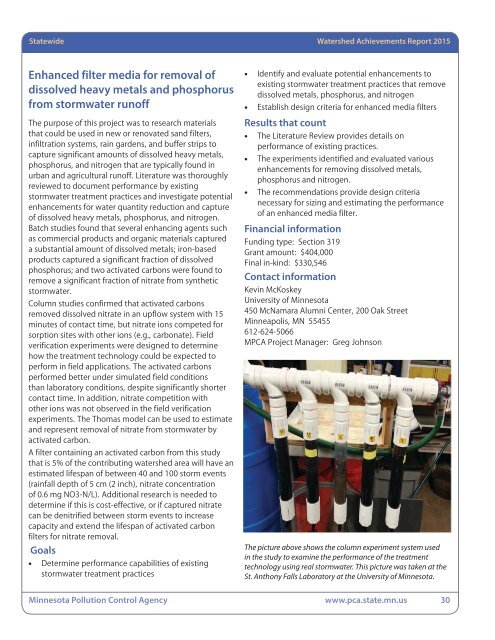Watershed Achievements Report
wq-cwp8-18
wq-cwp8-18
You also want an ePaper? Increase the reach of your titles
YUMPU automatically turns print PDFs into web optimized ePapers that Google loves.
Statewide <strong>Watershed</strong> <strong>Achievements</strong> <strong>Report</strong> 2015<br />
Enhanced filter media for removal of<br />
dissolved heavy metals and phosphorus<br />
from stormwater runoff<br />
The purpose of this project was to research materials<br />
that could be used in new or renovated sand filters,<br />
infiltration systems, rain gardens, and buffer strips to<br />
capture significant amounts of dissolved heavy metals,<br />
phosphorus, and nitrogen that are typically found in<br />
urban and agricultural runoff. Literature was thoroughly<br />
reviewed to document performance by existing<br />
stormwater treatment practices and investigate potential<br />
enhancements for water quantity reduction and capture<br />
of dissolved heavy metals, phosphorus, and nitrogen.<br />
Batch studies found that several enhancing agents such<br />
as commercial products and organic materials captured<br />
a substantial amount of dissolved metals; iron-based<br />
products captured a significant fraction of dissolved<br />
phosphorus; and two activated carbons were found to<br />
remove a significant fraction of nitrate from synthetic<br />
stormwater.<br />
Column studies confirmed that activated carbons<br />
removed dissolved nitrate in an upflow system with 15<br />
minutes of contact time, but nitrate ions competed for<br />
sorption sites with other ions (e.g., carbonate). Field<br />
verification experiments were designed to determine<br />
how the treatment technology could be expected to<br />
perform in field applications. The activated carbons<br />
performed better under simulated field conditions<br />
than laboratory conditions, despite significantly shorter<br />
contact time. In addition, nitrate competition with<br />
other ions was not observed in the field verification<br />
experiments. The Thomas model can be used to estimate<br />
and represent removal of nitrate from stormwater by<br />
activated carbon.<br />
A filter containing an activated carbon from this study<br />
that is 5% of the contributing watershed area will have an<br />
estimated lifespan of between 40 and 100 storm events<br />
(rainfall depth of 5 cm (2 inch), nitrate concentration<br />
of 0.6 mg NO3-N/L). Additional research is needed to<br />
determine if this is cost-effective, or if captured nitrate<br />
can be denitrified between storm events to increase<br />
capacity and extend the lifespan of activated carbon<br />
filters for nitrate removal.<br />
Goals<br />
• Determine performance capabilities of existing<br />
stormwater treatment practices<br />
• Identify and evaluate potential enhancements to<br />
existing stormwater treatment practices that remove<br />
dissolved metals, phosphorus, and nitrogen<br />
• Establish design criteria for enhanced media filters<br />
Results that count<br />
• The Literature Review provides details on<br />
performance of existing practices.<br />
• The experiments identified and evaluated various<br />
enhancements for removing dissolved metals,<br />
phosphorus and nitrogen.<br />
• The recommendations provide design criteria<br />
necessary for sizing and estimating the performance<br />
of an enhanced media filter.<br />
Financial information<br />
Funding type: Section 319<br />
Grant amount: $404,000<br />
Final in-kind: $330,546<br />
Contact information<br />
Kevin McKoskey<br />
University of Minnesota<br />
450 McNamara Alumni Center, 200 Oak Street<br />
Minneapolis, MN 55455<br />
612-624-5066<br />
MPCA Project Manager: Greg Johnson<br />
The picture above shows the column experiment system used<br />
in the study to examine the performance of the treatment<br />
technology using real stormwater. This picture was taken at the<br />
St. Anthony Falls Laboratory at the University of Minnesota.<br />
Minnesota Pollution Control Agency www.pca.state.mn.us 30


